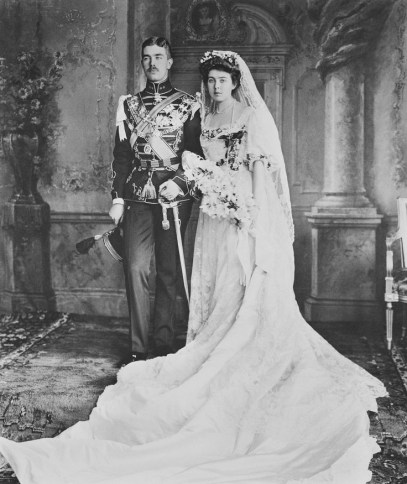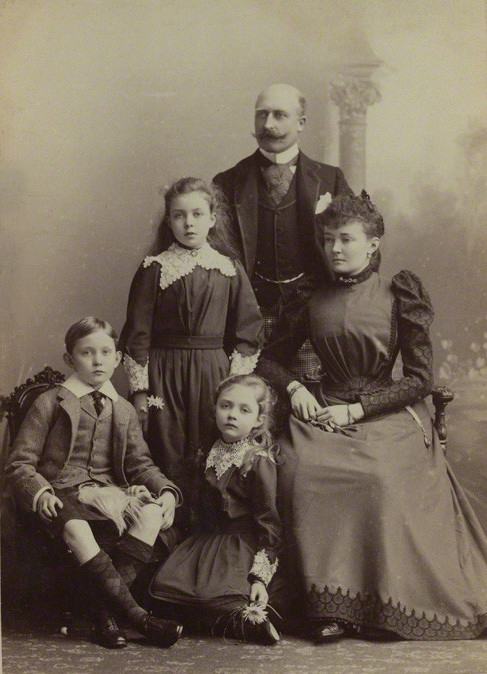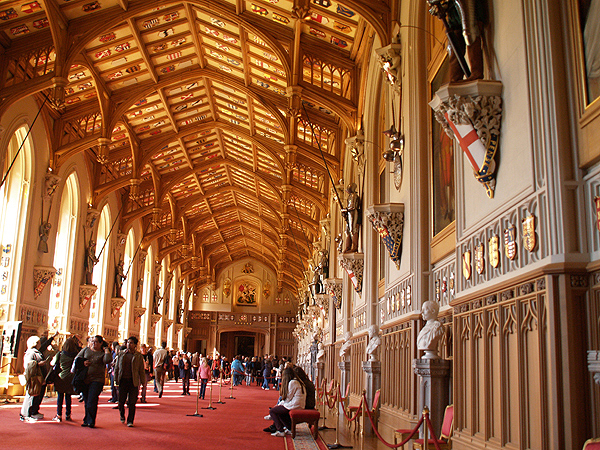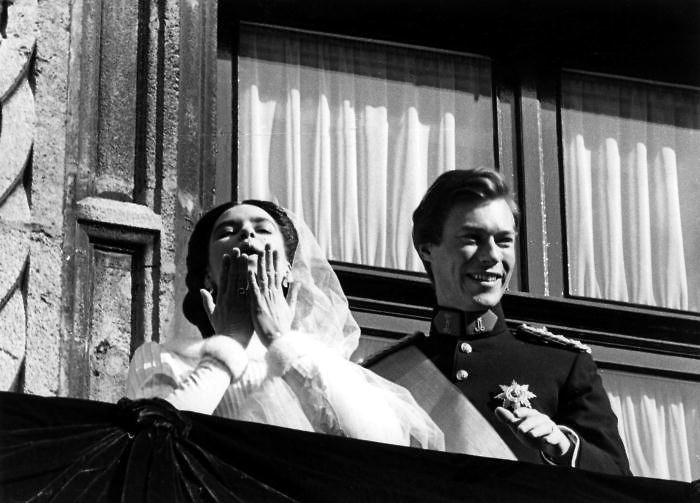by Susan Flantzer © Unofficial Royalty 2017
Prince Rainier III of Monaco married Grace Kelly on April 18, 1956, in a civil ceremony in the Throne Room of the Prince’s Palace in Monaco-Ville, Monaco, and in a religious ceremony on April 19, 1956, at St. Nicholas’ Cathedral in Monaco-Ville, Monaco.
Prince Rainier’s Family 
His Serene Highness Prince Rainier Louis Henri Maxence Bertrand Grimaldi was born on May 31, 1923, in Monaco. His parents were Count Pierre de Polignac and Princess Charlotte of Monaco, Duchess of Valentinois. Princess Charlotte was born Charlotte Louise Juliette Louvet, the illegitimate daughter of Marie Juliette Louvet, a cabaret singer, and Prince Louis II of Monaco. Prince Louis had no legitimate children and to prevent a cousin from succeeding to the Monegasque throne, in 1911 a law was passed recognizing Charlotte as his daughter and as a member of the princely family. Later, legislation made Charlotte legitimate, allowed her father to adopt her, and gave her the surname Grimaldi, and the title Duchess of Valentinois for life. Charlotte was, in effect, her father’s heiress presumptive.
Perhaps surprisingly, the Grimaldis have a number of major and minor royal ancestors including King James IV of Scotland (via three of his illegitimate daughters); Stéphanie de Beauharnais, Napoleon Bonaparte’s adopted daughter and later the Grand Duchess of Baden; William I (the Silent), Prince of Orange; King Charles IX of Sweden; Ferdinand I, Holy Roman Emperor; Claude de Lorraine, duc de Guise; and Hortense Mancini, Duchess of Mazarin, a mistress of King Charles II of England.
Rainier’s father, Count Pierre de Polignac, was the son of Count Maxence de Polignac, a French aristocrat, and Susana María de la Torre y Mier, whose family were descendants of Mexican nobility. On the de Polignac side of his family, Pierre was a descendant of Yolande de Polastron, Duchesse de Polignac, a favorite of Queen Marie Antoinette of France, and Gabrielle de Rochechouart de Mortemart, older sister of Françoise-Athénaïs de Rochechouart de Mortemart, better known as Madame de Montespan, the most celebrated mistress of King Louis XIV of France.
Charlotte and Pierre were married in a civil ceremony on March 19, 1920, and had a religious ceremony the following day. The day before the wedding an ordinance changed Pierre’s surname to Grimaldi and his coat of arms to those of the princely house. Pierre had been made a citizen of Monaco the month before the wedding. After the religious ceremony, he was known as Prince Pierre of Monaco, Duke of Valentinois. In addition to their son Rainier, the couple had a daughter Antoinette Louise Alberte Suzanne who was born December 28, 1920. Charlotte and Pierre’s marriage was an unhappy one. They separated on March 20, 1930, and were divorced by the ordinance of Prince Louis II on February 18, 1933.
On the day before Prince Rainier’s twenty-first birthday, Princess Charlotte renounced her claim to the throne of Monaco in favor of her son. Five years later, upon the death of his grandfather, Prince Louis II on May 9, 1949, Rainier became Rainier III, Sovereign Prince of Monaco. He died on April 6, 2005, after ruling Monaco for nearly 56 years.
For more information about Rainier see:
Grace Kelly’s Family
Grace Patricia Kelly was born on November 12, 1929, in Philadelphia, Pennsylvania. Her parents were John Brendan Kelly, the son of Irish immigrants, and Margaret Katherine Majer, the daughter of German immigrants. Grace’s mother Margaret, a former fashion model, had studied physical education at Temple University in Philadelphia and was the first woman to be head of the Physical Education Department at the University of Pennsylvania in Philadelphia. Grace’s father, known as Jack, had won three gold medals in rowing in the 1920 and 1924 Olympics. Jack had started his work career as a bricklayer and after serving in World War I, he created a bricklaying business that made him a millionaire.
Besides Grace, the Kellys had three other children: Margaret Katherine, known as Peggy, born on June 13, 1925; John Brendan, Jr., known as Kell, born on May 24, 1927, and Elizabeth Anne, known as Lizanne, born June 25, 1933. Grace’s brother Kell followed his father’s athletic footsteps and competed in rowing at the 1948, 1952, and 1956 Summer Olympics. He won a bronze medal in the 1956 Olympics. Interestingly, Grace’s son Albert participated in bobsledding in the Winter Olympics of 1988, 1992, 1994, 1998, and 2002 and has been a member of the International Olympic Committee since 1985.
Grace Kelly was a well-known film actress before her marriage. Among her films are: High Noon with Gary Cooper, Mogambo with Clark Gable, three Alfred Hitchcock films: Dial M for Murder with Ray Milland, Rear Window with James Stewart, and To Catch a Thief with Cary Grant, The Country Girl with Bing Crosby and William Holden for which Grace won an Academy Award for Best Actress, and her last film High Society with Bing Crosby and Frank Sinatra.
Tragically, Princess Grace died on September 14, 1982, from injuries received in an automobile accident.
For more information about Grace see:
Engagement and Ring
Since much of both Grace and Rainier’s lives were in the public eye, a private courtship was something of a task, especially considering the distance between the United States and Monaco. After meeting the Prince in Monaco during the Cannes Film Festival in May of 1955, Grace corresponded quietly with Rainier until he made a trip to the United States in December of that year. He asked Grace to marry him over the Christmas holiday, and on January 5, 1956, their engagement was announced in a press conference held at her family’s home in Philadelphia.
When Rainier proposed to Grace during the Christmas holiday of 1955, he gave her a “friendship” ring: a band set with diamonds and rubies. He also told her he was having a ring created especially for her.
An engagement ball was held in their honor at the Waldorf-Astoria hotel in New York on January 6, 1956, but by January 17th, Grace was due in Hollywood to begin filming “High Society” for MGM. When she went to California, Rainier went with her for a short time. In the film, Grace plays a young woman engaged to be married. She had selected a large, emerald cut, paste diamond engagement ring from MGM’s prop department to wear for the film, and when asked about her engagement ring, Grace would often flaunt the paste ring, claiming it was hers. During filming, the ring from Prince Rainier arrived, and Grace was astounded to find it remarkably similar to the paste ring she’d been wearing. She switched the rings immediately; which means the lovely diamond she’s seen polishing on a throw pillow in the movie is her actual engagement ring.
Before filming ended in February, Rainier returned to Monaco, and Grace began throwing herself actively into wedding plans and closing her New York apartment. She would not see Rainier again until she arrived in Monaco in April.
Sources:
“The Bridesmaids: Grace Kelly, Princess of Monaco, and Six Intimate Friends” by Judith Balaban Quine
“Princess Grace” by Sarah Bradford
“Rainier and Grace: An Intimate Portrait” by Jeffrey Robinson
“Grace: The Secret Lives of a Princess” by James Spada
Grace’s Trip to Monaco
Because air travel was not, in 1956, what it is today, Grace Kelly traveled to her wedding in Monaco by ship. She boarded the U.S.S. Constitution with her family, her bridal party, their families, and assorted friends for the voyage. There were 66 members of the party, plus the Weimaraner puppy Grace received as a wedding gift and her pampered poodle, Oliver.
Grace and her party boarded the ship at New York’s Pier 84 on April 4, 1956. Grace had intended to have a small press conference to announce her departure. Unfortunately, the media was overly anxious to get a few words and a few photos. Approximately 250 members of the press swarmed Grace as she stood on deck. Eventually, she was escorted away to the bridal suite by security, and the press was removed, in some cases bodily, to the dock.
The voyage lasted eight days. The days were spent visiting with friends and family and making last-minute preparations. Each evening there was a cocktail reception, followed by dinner and a party. Grace’s friends and family were fond of word games, cards, and charades and all these were played with great gusto.
Early on the morning of April 12, Prince Rainier boarded his yacht, the Deo Juvante, and set out into the Bay of Hercules. At approximately 9:45, the Constitution dropped anchor in the Bay, and the Prince’s yacht moved forward to meet it. As Grace’s party waited on deck, they could hear bands on the shore and on nearby boats playing American tunes and every window in Monte Carlo appeared to be open and filled with people. At that moment, a seaplane belonging to Aristotle Onassis flew over the harbor, dropping thousands of red and white carnations, the colors of Monaco, on the ships and crowds below. A gangway was extended between the two ships, and the Prince stepped forward to meet his fiancée. The whole country of Monaco held its breath… and was terribly disappointed when they actually saw Grace. For her arrival, she had chosen a navy blue coatdress and a broad-brimmed white hat. It was beautiful, but it prevented the crowds from seeing her face. The Prince, however, seemed overwhelmed by her appearance. After clasping her hand warmly and taking a moment to wave at the people both on boats and ashore, the Deo Juvante turned toward Monaco.
Sources:
“The Bridesmaids: Grace Kelly, Princess of Monaco, and Six Intimate Friends” by Judith Balaban Quine
“Princess Grace” by Sarah Bradford
“Rainier and Grace: An Intimate Portrait” by Jeffrey Robinson
“Grace: The Secret Lives of a Princess” by James Spada
The Trousseau
Grace began shopping for her trousseau at Neiman Marcus in Dallas. The exclusive store made suits, several gowns, numerous street dresses, and an entire wardrobe of sports clothes especially for her.
Her shopping continued in Los Angeles where she purchased negligees, nightgowns, and other lingerie items in pink, peach, and black. Other items such as stockings were purchased in New York, in addition to a number of everyday dresses and shoes. “Not too high in the heel,” the media noted of Grace’s new shoes, probably because she and Rainier were close in height. While in New York, Grace had many elegant hats made by prominent millinery designer, Mr. John. Last on the list were sable, mink and leopard skin coats.
When Grace Kelly left America for Monaco, she had four enormous steamer trunks and fifty-six other pieces of luggage holding not only her beautiful new clothes but a few well-worn sweatshirts and pairs of jeans, too.
Sources:
“The Bridesmaids: Grace Kelly, Princess of Monaco, and Six Intimate Friends” by Judith Balaban Quine
“Princess Grace” by Sarah Bradford
“Rainier and Grace: An Intimate Portrait” by Jeffrey Robinson
“Grace: The Secret Lives of a Princess” by James Spada
The Wedding Attendants
For the civil ceremony that took place on April 18, 1956, Grace and Rainier had five official witnesses. Grace’s sister Peggy and Rainier’s sister, Princess Antoinette, acted as her witnesses, and Rainier had his cousin Count Charles de Polignac, his good friend Lieutenant Colonel Jean-Marie Ardant, and Grace’s brother Kell.
For the religious ceremony on April 19, 1956, Grace asked six American friends and one of her sisters to attend her. Grace’s sister, Margaret (Peggy) Kelly Davis, was her matron of honor. The bridesmaids included Bettina Thompson Gray and Sally Parrish Richardson, with whom Grace had attended The American Academy of Dramatic Arts; Maree Frisby Pamp, who had known Grace since high school; Carolyn Scott Reybold, who had lived in the same residence hotel with Grace as they began their acting careers in New York; Rita Gam Lumet, another young actress from New York; and Judith Balaban Kanter who was, at that time, married to Grace’s agent, Jay.
The Prince had also asked his cousin, Count Charles de Polignac, Lieutenant Colonel Ardant, and John (Kell) Kelly to stand for him at the religious ceremony. In addition to these men, he had four spiritual advisors. One of them, Father Tucker, a priest from the United States, acted as “stage director” for Grace’s non-Catholic attendants. It was he who told them when to stand, to sit, and to kneel during the course of the ceremony and wedding Mass.
There were also four flower girls, Peggy’s daughters Meg and Mary Lee, and Princess Antoinette’s daughters Christine and Elisabeth, and two pages, Rainier’s cousin Sebastian Von Furstenberg, and Antoinette’s son, Christian.
Sources:
“The Bridesmaids: Grace Kelly, Princess of Monaco, and Six Intimate Friends” by Judith Balaban Quine
“Princess Grace” by Sarah Bradford
“Rainier and Grace: An Intimate Portrait” by Jeffrey Robinson
“Grace: The Secret Lives of a Princess” by James Spada
The Wedding Attire
For the civil ceremony, Grace wore a two-piece dress of light pink taffeta overlaid with champagne lace. She accessorized the dress with matching Cuban heeled shoes, a pleated chiffon turban adorned with flowers, and white gloves. The Prince wore a morning coat, gray trousers, white waistcoat, and gray silk tie. The gentlemen witnesses wore dark suits, and the ladies wore tea-length dresses and hats.
Grace’s wedding gown for the religious ceremony was a gift from MGM. It was created by Helen Rose, MGM’s costume designer and personal friend of Grace. The nearly 320 yards of lace used for the bodice and train was antique and had been purchased from a museum for an estimated $2,500. In addition, Ms. Rose used 25 yards of silk peau de soie, 25 yards of silk taffeta, and approximately 100 yards of silk tulle. The gown had a high, stiffened lace collar with a close-fitting bodice and arms. It buttoned down to a silk cummerbund and then descended in a perfect bell shape to the floor. The back of the gown was a marvel, the silk skirt dividing in such a way that the antique lace and tulle seemed to flow from the waist into a long, graceful train. The three petticoats beneath were so well made that the designer admitted they could have been worn separately as evening dresses. Each was decorated with tiny blue bows, “something blue”. The bodice and Grace’s lace Juliet cap were re-embroidered with seed pearls, as were her shoes. Ninety yards of tulle tied with bows of taffeta and lace constituted her veil.
Rainier wore a dress uniform he had designed himself, which included a black tunic with gold leaves on the cuffs, sky blue trousers with a gold stripe down the side, and a dark blue tricorn hat with a white ostrich plume. The tunic was graced with medals representing the Prince’s links with Italian and French military history, and across his chest hung the red and white sash representing the Order of St. Charles.
The bridesmaids wore pale yellow organdy dresses which had been custom-made at Neiman Marcus, with yellow organdy hats and wrist-length white gloves. The pages were dressed in white suits with trousers banded at the knee, and the four flower girls wore mid-calf length dresses of white broderie anglaise from Neiman Marcus, short white socks, and white shoes from J.C. Penney.
Sources:
“The Bridesmaids: Grace Kelly, Princess of Monaco, and Six Intimate Friends” by Judith Balaban Quine
“Princess Grace” by Sarah Bradford
“Rainier and Grace: An Intimate Portrait” by Jeffrey Robinson
“Grace: The Secret Lives of a Princess” by James Spada
The Wedding Guests
Given the diverse backgrounds of the bride and groom, the guest list for their wedding ceremonies was equally unusual. Representatives of dozens of nations and royal families were in attendance, including Sir Guy Salisbury-Jones representing the British royal family, Conrad Hilton who represented President Eisenhower, and Francois Mitterrand, then Minister of Justice, representing France. The Aga Khan, in his wheelchair, made the trip to Monaco, accompanied by his wife and guards who protected them 24 hours a day.
Ex-King Farouk of Egypt and Randolph Churchill, personal friends of the Prince’s, were present. Churchill and the Duchess of Westminster were invited guests who also provided insights on the pageantry to the British press. Conversely, Hollywood columnist Dorothy Kilgallen was a reporter first and a guest second.
Aristotle Onassis, who had showered Monaco with flowers when Grace arrived, was also there for the religious ceremony accompanied by his wife, Tina. Barney Balaban, a founder of Paramount Pictures, and his wife made the trip from America. Their daughter, Judy Kanter, was one of Grace’s bridesmaids. Somerset Maugham, along with other luminaries, boarded small buses for the trip to the church since parking was unavailable. Monseigneur Paul Marella, the Apostolic Nuncio of Paris, represented Pope Pius XII and carried blessings from the Pontiff.
Also included were Grace’s showbiz friends. Broadway producer Gant Gaither and actor Donald Buka made the trip with the Kelly family aboard the U.S.S. Constitution. Grace’s close friend from Hollywood, Rupert Allen, sat with Ava Gardner, whom Grace had befriended when they worked on “Mogambo”. Actress Gloria Swanson also attended along with MGM publicist Morgan Hudgins and Mr. and Mrs. David Niven.
The most prominent guest at both ceremonies was the world. MGM, in exchange for releasing Grace from her contract, was permitted to film both events for broadcast on television and the silver screen.
Sources:
“The Bridesmaids: Grace Kelly, Princess of Monaco, and Six Intimate Friends” by Judith Balaban Quine
“Princess Grace” by Sarah Bradford
“Rainier and Grace: An Intimate Portrait” by Jeffrey Robinson
“Grace: The Secret Lives of a Princess” by James Spada
The Ceremony
Because of the intricacies of Monegasque law, Grace and Rainier were married twice, once in a civil ceremony and once in a religious ceremony. The civil ceremony took place on April 18, 1956, in the Throne Room of the palace. At eleven o’clock, Monsieur Marcel Portanier, President of the State Council of Monaco began the ceremony by asking Prince Rainier if he had permission to proceed. After Rainier answered, “Oui,” Monsieur Portanier read the Articles of the Civil Code detailing the rights and obligations of the pair, followed by the vows, and a list of the Prince’s 142 official titles. Once they were finished, they had to go through the entire 40-minute ceremony again for the MGM cameras present.
The religious ceremony took place the following day. At 10:30 a.m., Grace and her attendants arrived at the church which was filled with white lilacs and lilies of the valley. When Rainier arrived a few minutes later, the ceremony began. As with many weddings, there were a few small glitches. One page dropped Rainier’s ring, and the Prince struggled to put Grace’s ring on her finger. The Choir School of the Cathedral sang Bach’s “Uxor Tua” and Purcell’s “Alleluia”. After both Grace and Rainier had quietly answered “Yes” to the vows posed to them, Monseigneur Paul Marella, representative of Pope Pius XII, gave a blessing from the Pope and the ceremony was complete.
Sources:
“The Bridesmaids: Grace Kelly, Princess of Monaco, and Six Intimate Friends” by Judith Balaban Quine
“Princess Grace” by Sarah Bradford
“Rainier and Grace: An Intimate Portrait” by Jeffrey Robinson
“Grace: The Secret Lives of a Princess” by James Spada
The Reception
Since Prince Rainier and Grace Kelly had two wedding ceremonies, they also had two receptions. For the first reception, following the civil ceremony, the courtyard of Monaco’s pink palace was opened and approximately 3,000 Monegasques sipped champagne and ate cake along with the members of the wedding party and other family members.
The second wedding reception, following the religious ceremony, was much more elaborate and limited to the 600 guests who attended the service. The luncheon buffet included caviar, smoked salmon, shrimp, ham, salami, soup, cheese, jellied eggs, salmon with cucumber salad, cold lobster, and chicken, accompanied by champagne. Because seating space was limited, attendees had to juggle not only their plates and glasses, but also gloves, programs, hats, handbags, or anything else they had been carrying.
Grace and Rainier’s wedding cake was a culinary masterpiece. There were six tiers in all, making it taller than both the bride and groom. The first level was decorated with three-dimensional replicas of Monaco’s pink palace carved from sugar. Each of the other layers held scenes from Monaco’s history crafted gently into the sides, and between the fourth and fifth layers, the Monegasque crest was duplicated in red and white spun sugar. The top held two cherubs standing upon clouds of filigreed icing, with a replica of the crown of Monaco suspended above their heads.
As with so many royals, the Prince and Princess used Rainier’s ceremonial sword to cut the cake which was then packaged in white faille boxes decorated with white and gold rope and the intertwined initials “R” and “G”, tied with a golden cord, and distributed amongst the guests.
Sources:
“The Bridesmaids: Grace Kelly, Princess of Monaco, and Six Intimate Friends” by Judith Balaban Quine
“Princess Grace” by Sarah Bradford
“Rainier and Grace: An Intimate Portrait” by Jeffrey Robinson
“Grace: The Secret Lives of a Princess” by James Spada
The Honeymoon
Following the religious ceremony on April 19, 1956, Grace and Rainier sailed into the sunset aboard the royal yacht, Deo Juvante. They did not get very far at first. Once the yacht had left the Bay of Hercules, Rainier and the crew gave in to Grace’s obvious illness and anchored the ship for the night to allow her a chance to adjust. Unfortunately, it proved to be a bit more than seasickness, and Grace spent the first week of her honeymoon with the flu. After that, the couple spent several weeks cruising the Riviera, the coast of Spain where they met and spent time with friends, and Corsica, where days were spent lounging on sun-drenched beaches.
Sources:
“The Bridesmaids: Grace Kelly, Princess of Monaco, and Six Intimate Friends” by Judith Balaban Quine
“Princess Grace” by Sarah Bradford
“Rainier and Grace: An Intimate Portrait” by Jeffrey Robinson
“Grace: The Secret Lives of a Princess” by James Spada
Children

Rainier, Grace and their three children; Photo source: The Telegraph
- Princess Caroline, Princess of Hanover (born 1957), married (1) Philippe Junot, no children, marriage annulled (2) Stefano Casiraghi, had two sons and one daughter (3) Prince Ernst August of Hanover, had one daughter
- Prince Albert II (born 1958), married Charlene Wittstock, had twin son and daughter, Princely Family of Monaco descends from this marriage; Albert also has one illegitimate daughter and son
- Princess Stéphanie (born 1965), married (1) Daniel Ducruet, had two children, divorced (2) Adans Lopez Peres, no children, divorced; Stephanie has one illegitimate daughter
This article is the intellectual property of Unofficial Royalty and is NOT TO BE COPIED, EDITED, OR POSTED IN ANY FORM ON ANOTHER WEBSITE under any circumstances. It is permissible to use a link that directs to Unofficial Royalty.















































.jpg?resize=538%2C403)































+as+Lucia-bride+with+her+little+sister+Benedikte.jpg?resize=361%2C442)





